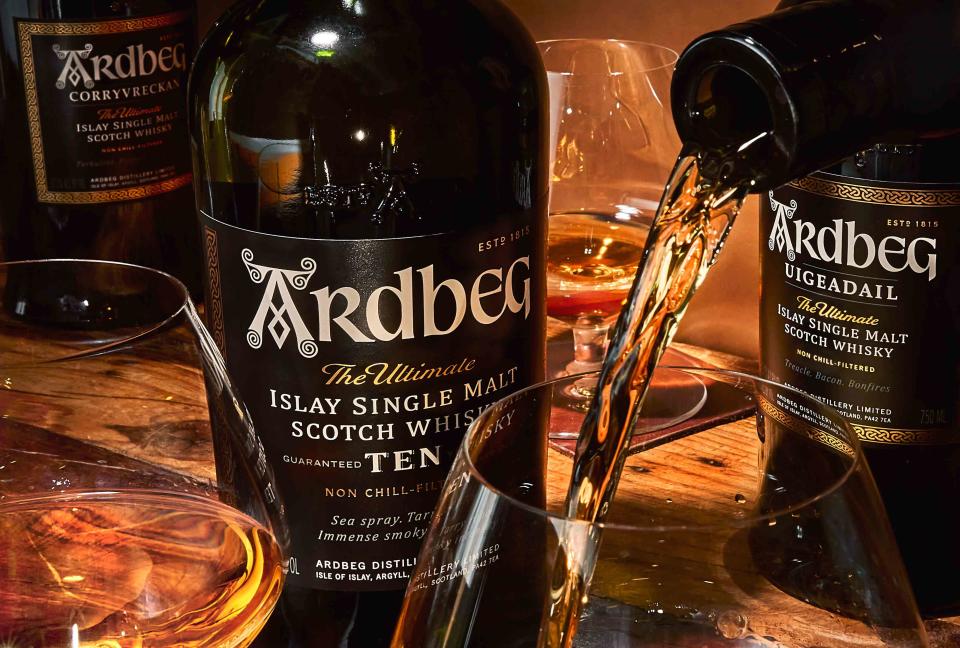One of the World’s Best Scotches Owes Its Success to Aliens, Pirates, and Spaceships
Ardbeg is a whiskey to savor.

Greg DuPree / Food Styling by Chelsea Zimmer / Prop Styling by Christine Keely
You know that moment when a song, film, or some external force meets your atoms and electrifies them, and suddenly you’re unable to imagine your life before it? That was my first sip of Ardbeg Corryvreckan, chosen for me by the whiskey librarian at a lochside resort in the West Highlands of Scotland after I described my especially smoky, peaty tastes. I found a new devotion.
The brand’s master distiller, Bill Lumsden, told me rather proudly that the whiskey brand “attracts weirdos,” and having attended the 14th annual Ardbeg Day festivities in June 2023, I took that for the compliment it was.
In the past 200-plus years, Ardbeg has harnessed the native flora, water, and climatic idiosyncrasies of Islay, a sparsely populated island off the west coast of Scotland, to create its signature whiskeys. It’s not easy to get to Islay—especially when you’re toting a full-size banana costume (in honor of Ardbeg’s Blasda offering, which was notorious for its banana notes), pirate gear (Arrrrrrrdbeg!), or steampunk astronaut helmet (their single malt Supernova whiskey spent time on a space station) on the twice-daily ferry or white-knuckle flight from Glasgow. Still, every year, thousands do so—in full costume—for the chance to get their hands on that year’s extremely limited release, eat peat-smoked Scottish snacks while dancing next to a distillery building decked with massive inflatable tentacles, and commune with their fellow odd spirits.
Related: Single Malt and Blended Whisky — What's the Difference?
I took a moment to sneak away from the revelry and stand in the dirt-floored warehouse, where the air smelled so alien to my daily life in Brooklyn that I may as well have been on another planet. Racks of oak casks stretched into infinity, silently transmogrifying the liquid within until it properly became Ardbeg.
In 1981, the distillery fell on hard times and shut down, and the whiskey that was still in the warehouse simply rested there. The company was acquired in 1987 and resumed limited production a couple of years later, and then in 1997, Glenmorangie summoned Ardbeg back to life. Since then, the distillery has been doling out that legacy stock in various limited releases. Once the rest of that bottling is gone, it’s gone.
I asked Lumsden how he was planning to commemorate his final sips from the 1981 and 1989 stock, which Ardbeg has issued together as the Rollercoaster collection. He told me he’d likely put on some jazz and take periodic whiffs from the tasting glass for as long as it held the aroma. What a “weirdo.” I can’t imagine doing it any other way.
Related: The Best Damn Wine Club I Ever Joined
Our Favorite Ardbegs
Ardbeg 10 Year Old ($70)
This is the baseline, the starting point, the begin-your-quest Ardbeg: peaty, smoky, intense, and with a whiff of seaside salt.
Ardbeg Corryvreckan ($130)
Aging in a percentage of American bourbon barrels gives this expression a spicier top note and an alluring complexity.
Ardbeg Uigeadail ($99)
Pronounced “oo-guh-dahl,” Uigeadail is a bit more luscious and Christmas-spicy and less peppery and intense than Corryvreckan.
For more Food & Wine news, make sure to sign up for our newsletter!
Read the original article on Food & Wine.

